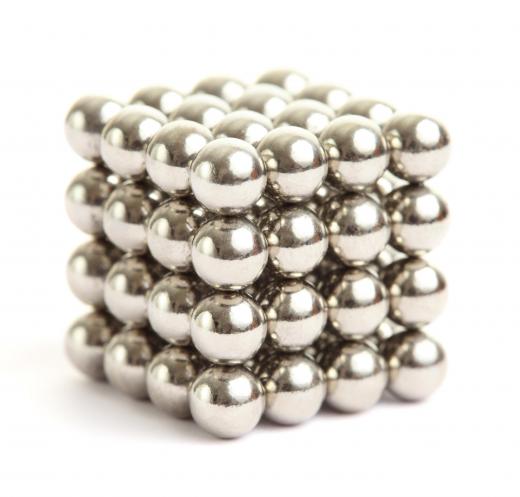What is a Neodymium Magnet?
 Michael Anissimov
Michael Anissimov
Neodymium is the most powerful permanent magnetic material of which scientists are currently aware. It is also affordable, making it suitable for myriad applications. The chemical composition of a neodymium magnet is Nd2Fe14B, which is two atoms of neodymium, 14 iron atoms, and one boron atom. They are rare-earth magnets, in contrast to conventional ferrite and ceramic magnets, which means that they contain atoms from either the lanthanide or actinide series in the periodic table.
Magnets made with neodymium are the strongest of the rare-earth magnets. Their strength is often given in terms of its gauss rating; depending on their shape and grade, this type of magnet may rate 13,500 gauss or more, although a small one usually rates about 2,000 gauss. By comparison, a refrigerator magnet rates about 50 gauss.

Because they are inexpensive, these magnets are used quite frequently in industry and among hobbyists and dabblers. For example, every computer hard drive has a small neodymium magnet which helps direct the needle that reads data. They can also be found in high-end speakers and science classrooms around the world.
One of the only downsides is that its magnetic field loses some intensity when temperatures are too high. This precludes their use in electronics applications in which a lot of heat is generated. There are versions of the neodymium magnet that perform better under higher temperatures, but in these cases strength must be sacrificed.

Neodymium magnets are incredibly strong; one the size of a US quarter (about 1 inch (24.26 mm) in diameter) can suspend a piece of iron weighing dozens of pounds (kilograms). Two snapping together at the wrong angle can pinch the skin and draw blood. Larger neodymium magnets can be extremely dangerous, wiping credit cards, sending metallic objects flying, and potentially breaking bones if used without care.
For all their danger, neodymium magnets can be used in numerous fun and educational projects. Ferrofluid and magnetic viewing film are commonly used to view magnetic field lines in a physical medium. Carefully arranged neodymium magnets can cause diamagnetic levitation, a peculiar phenomenon that can even levitate live objects such as some frogs. If someone tries to drag one along a non-magnetic conductive surface such as aluminum, it will engage in "magnetic breaking" and be extremely difficult to move. Due to their incredible strength, however, their use is best left to cautious adults.
AS FEATURED ON:
AS FEATURED ON:












Discussion Comments
Neodymium magnets are stagnant and remain stable at temperature. These magnets are widely used in industry. These types of magnets can be used in numerous fun and educational projects.
Magnets and ferrites are often a relatively low cost part of a great many pieces of equipment but their importance is extremely high.
@anon129664: It depends, but I'm pretty sure nearly all neodymium magnets can withstand up to 80 degrees celsius, but you can also buy some which can go up to 180 degrees or more, expect 80 degrees unless told otherwise when buying the magnet.
Also, while it will lose its magnetisation, you can remagnetise any magnetic material by stroking it repeatedly in the desired direction with another magnet, although I doubt you'll be able to bring it up to anywhere near its original strength.
If you're using it in high temperature environments, you're going to need to get some advice from a professional about the best way to protect it.
what degree of temperature are we taking about? I mean what temperature would it be needed for these magnets to lose their magnetism?
@Anon5982: For different grades of Nedymium manets, the maximum working temperature is different. If the operation temperature is above the maximum working temperature, the magnet will be demagnetized. When it cools, it will not regain magnetization.
the magnet will wipe out your Iphone electronic data and it won't work anymore. be careful.
Does anyone know what affect a neodymium magnet, on a bracelet, may or may not have on a 3G iphone?
AFAIK, all magnets lose their magnetic properties when heated. It's called the Curie point. And no, they don't regain their magnetism unless remagnetized using an external magnetic field.
where can you buy such magnets if they are only 1 dollar?
the article says that the neodymium loses its magnetism at high temperatures. is this a permanent effect, or does it regain magnetism when it cools? please reply. i am very interested in this.
Post your comments